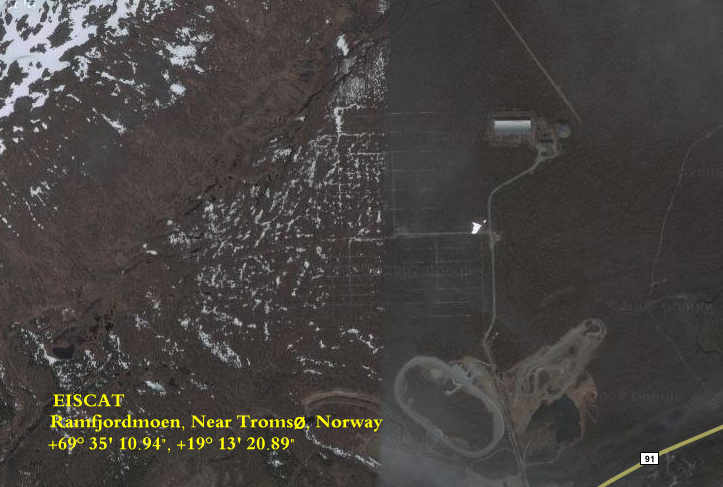Buscar
Conectarse
¿Quién está en línea?
En total hay 14 usuarios en línea: 0 Registrados, 0 Ocultos y 14 Invitados :: 1 Motor de búsquedaNinguno
El record de usuarios en línea fue de 1301 durante el 1/7/2011, 08:48
EISCAT (European Incoherent Scatter Scientific Association) - HAARP Europeo
Página 1 de 1.
 EISCAT (European Incoherent Scatter Scientific Association) - HAARP Europeo
EISCAT (European Incoherent Scatter Scientific Association) - HAARP Europeo
EISCAT
EISCAT is an acronym for the European Incoherent Scatter Scientific Association. It operates three incoherent scatter radar systems, at 224 MHz, 931 MHz in Northern Scandinavia and one at 500 MHz on Svalbard, used to study the interaction between the Sun and the Earth as revealed by disturbances in the ionosphere and magnetosphere. At the Ramfjordmoen facility (near Tromsø, Norway) it also operates an ionospheric heater facility, similar to HAARP. Additional receiver stations are located in Sodankylä, Finland, and Kiruna, Sweden. The EISCAT Headquarters are also located in Kiruna.
EISCAT is funded and operated by research institutes and research councils of Norway, Sweden, Finland, Japan, China, the United Kingdom and Germany.
In 2008, Doritos embarked upon an "out-of-this-world" advertising campaign, literally beaming a 30sec ad for Doritos brand tortilla chips into a solar system 42 light years away. This project is in collaboration with EISCAT Space Centre in Svalbard, Norway. The "You Make It, We'll Play It" contest chose the winning advertisement that was transmitted on June 12, 2008. The ad was beamed towards a distant star, within the Ursa Major constellation, that is orbited by planets which may harbor life.[1]
History
In 1973 the EISCAT proposal - which was originally planned for France, Germany and the three Nordic countries seemed moribund. Then a Welshman, Granville Beynon became involved and by 1975 the agreement was signed, with the UK as a member. The proposal for UK membership had originally been turned down by the appropriate SRC committee. Beynon, however, persuaded the Board to reverse the decision of the committee and as a result of his efforts hundreds of European scientists have had the opportunity to use the world's most advanced ionospheric radar.
Fuente: Web - Español
Kamus: Es muy probable que estas instalaciones en Tromsø (Noruega) de uso similar al HAARP son las que causaron el rayo azul que manipulo la atmosfera.

Kamus- Cantidad de envíos : 3536
Nivel de Aportación : 6626
Fecha de inscripción : 01/11/2009
Localización : Matrix Holografica
 European Incoherent Scatter Scientific Association
European Incoherent Scatter Scientific Association
Ramfjordmoen, Near Tromsø, Norway
+69° 35' 10.94", +19° 13' 20.89"
The EISCAT
The EISCAT Scientific Association is an international research organisation operating three incoherent scatter radar systems, at 931 MHz, 224 MHz and 500 MHz, in Northern Scandinavia. It is funded and operated by the research councils of Norway, Sweden, Finland, Japan, France, the United Kingdom and Germany (collectively, the EISCAT Associates).
EISCAT (European Incoherent Scattter) studies the interaction between the Sun and the Earth as revealed by disturbances in the magnetosphere and the ionised parts of the atmosphere (these interactions also give rise to the spectacular aurora, or Northern Lights). The radars are operated in both Common and Special Programme modes, depending on the particular research objective, and Special Programme time is accounted and distributed between the Associates according to rules which are published from time to time.
One EISCAT transmitter site is located close to the city of Tromsø, in Norway, and additional receiver stations are located in Sodankylä, Finland, and Kiruna, Sweden. See an animation that shows the basic operation. The EISCAT Headquarters are also located in Kiruna. 1996 the EISCAT Scientific Association constructed a second incoherent scatter radar facility, the EISCAT Svalbard Radar, near Longyearbyen on the island of Spitsbergen, far to the North of the Norwegian mainland.
The Incoherent Scatter Radar technique requires sophisticated technology and EISCAT engineers are constantly involved in upgrading the systems.
In addition to the incoherent scatter radars, EISCAT also operates an Ionospheric Heater facility at Ramfjordmoen (including a Dynasonde) to support various active plasma physics experiments in the high latitude ionosphere.
SOURCE ARTICLE
www.eiscat.se:8080
Tromsø 931 MHz Ultra High Frequency Radar [facts]
These signals are also received at Kiruna and Sodankylä
Tromsø 224 MHz Very High Frequency Radar [facts]
We have also a heating facility and a Dynasonde
Fuente: Web - Español

Kamus- Cantidad de envíos : 3536
Nivel de Aportación : 6626
Fecha de inscripción : 01/11/2009
Localización : Matrix Holografica
 European Incoherent Scatter Scientific Association
European Incoherent Scatter Scientific Association
EISCAT - MORRO radar
Description
The MORRO radar is an MST (Mesosphere-Stratosphere-Troposphere) radar operated by the Department of Physics and Technology (IFT) of the University of Tromsø (UiT) in Norway. The radar is co-located with the EISCAT facility in Ramfjordmoen near Tromsø. The facility hosts two large incoherent scatter radars (VHF, 224 MHz; UHF, 930 MHz), a Heating facility, a meteor radar, an MF radar, digital ionosondes and optical observatories to investigate the Northern Lights.
The immediate purpose of the MORRO radar is the investigation of Polar Mesospheric Summer Echoes (PMSE) and Polar Mesospheric Winter Echoes (PMWE). Of especial interest are dusty plasma physics processes and atmospheric turbulence associated with these echoes. The potential applications of the radar extends well beyond the ability to measure the two mentioned phenomena, a potential that will be exploited in due time, in particular the dynamics, energy budget and coupling of the atmospheric regions, troposphere, stratosphere mesosphere and middle atmosphere.
Of especial interest are the exploitation of the scientific opportunities created by the unique availability of a number of powerful and complementary instruments for the study of the atmosphere, the middle atmosphere and the ionosphere. The Heating facility offers the unique capability to modify the object of investigation, such as PMSE and PMWE, in a controlled manner which enhances considerably the ability to investigate and understand these phenomena and many others.
Fuente: Web - Español
EISCAT Tromsø UHF radar and aurora.

Kamus- Cantidad de envíos : 3536
Nivel de Aportación : 6626
Fecha de inscripción : 01/11/2009
Localización : Matrix Holografica
 EISCAT - Anuncio comercial dirigido a ETs
EISCAT - Anuncio comercial dirigido a ETs
El primer anuncio para alienígenas ya surca el cosmos
El reclamo sideral es parte de una campaña de "Doritos" -la famosa marca de "snacks" hechos con harina de maíz, aceite y saborizantes-, que se ha asociado con los científicos de la Universidad de Leicester (centro de Inglaterra) para marcar ese hito histórico.
Por primera vez en la Historia de la publicidad, un anuncio se lanzó hoy al espacio para tentar con aperitivos de maíz a posibles consumidores extraterrestres.
El reclamo sideral es parte de una campaña de "Doritos" -la famosa marca de "snacks" hechos con harina de maíz, aceite y saborizantes-, que se ha asociado con los científicos de la Universidad de Leicester (centro de Inglaterra) para marcar ese hito histórico.
El lanzamiento supone "un pequeño paso para el hombre, pero un gran salto para la publicidad", afirmaron los expertos de Leicester al parafrasear las célebres palabras del astronauta Neil Armstrong en 1969, cuando se convertió en el primer humano en pisar la Luna.
El anuncio se transmitió desde el potente Radar de Ultra Frecuencia de 500 megahertzios del Centro Espacial de la EISCAT (Asociación Científica Europea de Radares de Dispersión Inconexa), radicado en el archipiélago ártico de Svalbard, entre Noruega y el Polo Norte.
El mensaje publicitario va dirigido a potenciales clientes alienígenas de un sistema solar localizado a 42 años luz de la Tierra y cuyos planetas orbitan en torno a la estrella "47 Ursai majoris" (UMA-47), que se halla en la Constelación de la Osa Mayor.
Según los científicos, este anuncio, que viaja a la velocidad de la luz, tardó poco más de un segundo en pasar la Luna, cuatro minutos y medio en dejar atrás Marte, nueve minutos en rebasar el Sol y unas cinco horas y media en abandonar nuestro sistema solar.
A ese ritmo fulminante, el anuncio intergaláctico puso rumbo a "un planeta identificado en un sistema solar, en el que podría haber una 'zona habitable' (región sideral con condiciones especiales para la vida)", explicó a Efe el profesor Darren Wright, del departamento de Física y Astronomía de la Universidad de Leicester.
El anuncio -que es un vídeo de treinta segundos seleccionado en un concurso público abierto por la marca de aperitivos en el Reino Unido- muestra a una tribu de "Doritos" que escapa de una bolsa y sacrifica a uno de sus miembros como tributo al Dios de la Salsa.
Sin embargo, los alienígenas no verán las imágenes de tan bárbaro ritual, pues la grabación se ha codificado con un sistema binario -de ceros y unos- con la finalidad de que cualquier vida inteligente "ahí fuera", en el espacio, pueda descifrarla matemáticamente sin mayores complicaciones.
De cualquier manera, "no hay forma de saber si otras especies inteligentes entenderán el concepto de 'Doritos' o, incluso, el de comida", admitió el director de EISCAT, Tony van Eyken.
El "cebo" publicitario se espera que alcance los planetas que giran alrededor de la UMA-47 en el año 2050, mientras que una eventual respuesta extraterrestre -quizás una orden de compra del piscolabis en cuestión- no llegaría a la Tierra antes de 2092.
Aparte del valor científico del experimento, el profesor Wright cree que "podría surgir un interés comercial en empresas como ésta".
"Imagínese -argumentó el académico de Leicester- que las compañías de la Tierra deseasen algún día anunciarse en otras colonias planetarias de nuestro sistema solar. ¡Por ejemplo, si el hombre llega algún día a colonizar Marte!".
Aunque es una inversión a largo plazo y habrá que armarse de paciencia para conocer el resultado comercial del anuncio, la compañía patrocinadora se ha comprometido, de momento, a hacer una donación a los astrónomos de Leicester, que precisan de fondos para desentrañar los múltiples enigmas que esconde el espacio interestelar.
Y si resultase que los extraterrestres rechazasen estos deliciosos aperitivos de maíz, los terrícolas podrían respirar tranquilos, pues, según aseguró Tony van Eyken, no existe ningún "riesgo de ataque alienígena".
Fuente: Web

Kamus- Cantidad de envíos : 3536
Nivel de Aportación : 6626
Fecha de inscripción : 01/11/2009
Localización : Matrix Holografica
Contenido patrocinado
 Temas similares
Temas similares» Noruega - Misterioso rayo azul forma una Espiral en el cielo
» El 5 de febrero de 1998 la Subcomisión de Seguridad y Desarme del Parlamento Europeo celebró una audiencia sobre, entre otras cosas, el HAARP
» Nace la NIA (National Inflation Association) en USA.
» European Extremely Large Telescope (E-ELT) - Gran Telescopio (Chile)
» El Tratado Europeo de Lisboa
» El 5 de febrero de 1998 la Subcomisión de Seguridad y Desarme del Parlamento Europeo celebró una audiencia sobre, entre otras cosas, el HAARP
» Nace la NIA (National Inflation Association) en USA.
» European Extremely Large Telescope (E-ELT) - Gran Telescopio (Chile)
» El Tratado Europeo de Lisboa
Página 1 de 1.
Permisos de este foro:
No puedes responder a temas en este foro.











